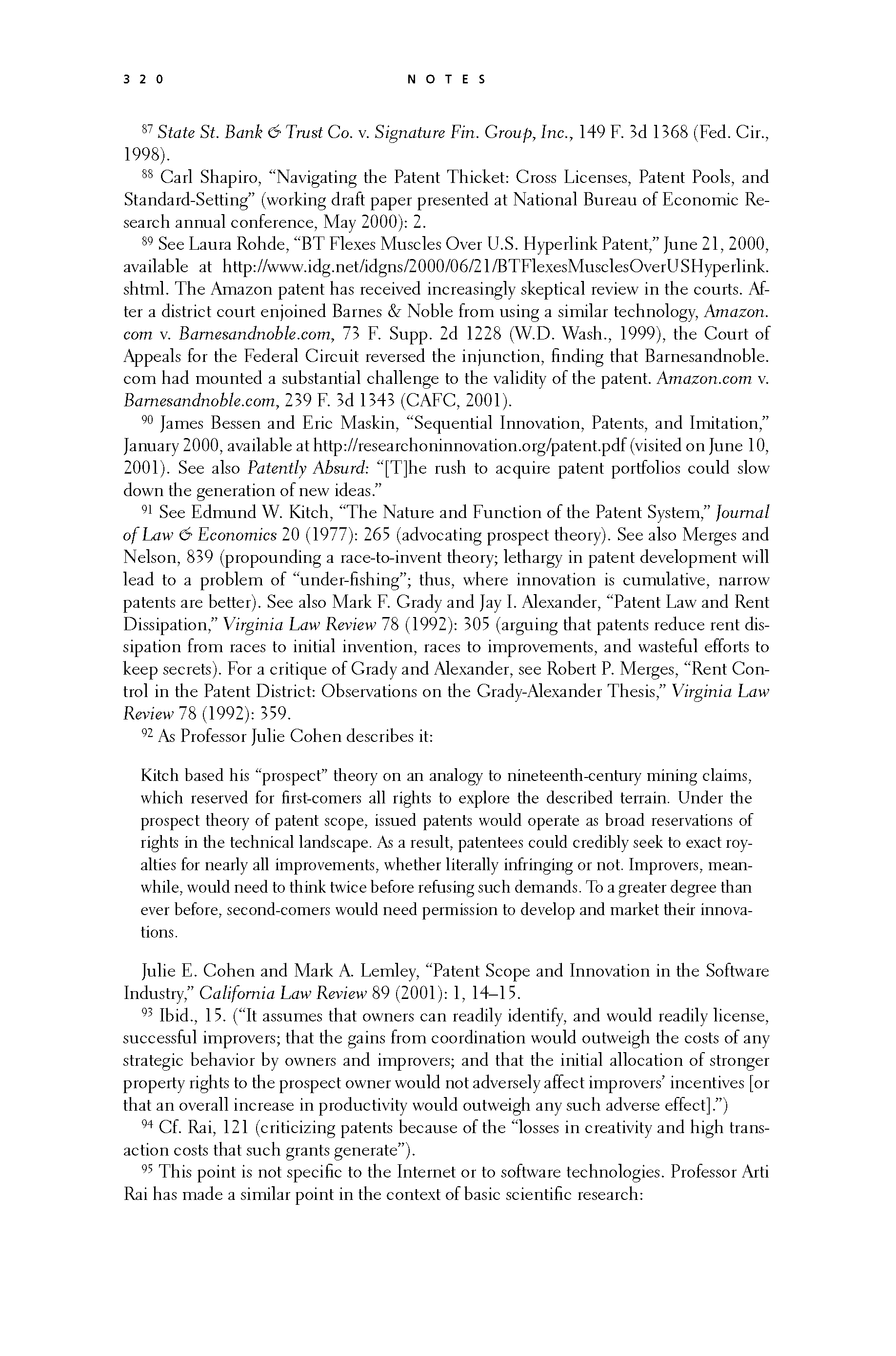 p319 _
-chap- _
toc-1 _
p320w _
toc-2 _
+chap+ _
p321
p319 _
-chap- _
toc-1 _
p320w _
toc-2 _
+chap+ _
p321
[11-87] _State_St._Bank_&_Trust_Co._ v. _Signature_Fin._Group,_Inc.,_ 149 F. 3d 1368 (Fed. Cir.,
1998).
[11-88] Carl Shapiro, "Navigating the Patent Thicket: Cross Licenses, Patent Pools, and
Standard-Setting" (working draft paper presented at National Bureau of Economic Re-
search annual conference, May 2000): 2.
[11-89] See Laura Rohde, "BT Flexes Muscles Over U.S. Hyperlink Patent," June 21, 2000,
available at http://www.idg.net/idgns/2000/06/21/BTFlexesMusclesOverUSHyperlink.
shtml. The Amazon patent has received increasingly skeptical review in the courts. Af-
ter a district court enjoined Barnes & Noble from using a similar technology, _Amazon._
_com_ v. _Barnesandnoble.com,_ 73 F. Supp. 2d 1228 (W.D. Wash., 1999), the Court of
Appeals for the Federal Circuit reversed the injunction, finding that Barnesandnoble.
com had mounted a substantial challenge to the validity of the patent. _Amazon.com_ v.
_Barnesandnoble.com,_ 239 F. 3d 1343 (CAFC, 2001).
[11-90] James Bessen and Eric Maskin, "Sequential Innovation, Patents, and Imitation,"
January 2000, available at http://researchoninnovation.org/patent.pdf (visited on June 10,
2001). See also _Patently_Absurd:_ "[T]he rush to acquire patent portfolios could slow
down the generation of new ideas."
[11-91] See Edmund W. Kitch, "The Nature and Function of the Patent System," _Journal_
_of_Law_&_Economics_ 20 (1977): 265 (advocating prospect theory). See also Merges and
Nelson, 839 (propounding a race-to-invent theory; lethargy in patent development will
lead to a problem of "under-fishing"; thus, where innovation is cumulative, narrow
patents are better). See also Mark F. Grady and Jay I. Alexander, "Patent Law and Rent
Dissipation," _Virginia_Law_Review_ 78 (1992): 305 (arguing that patents reduce rent dis-
sipation from races to initial invention, races to improvements, and wasteful efforts to
keep secrets). For a critique of Grady and Alexander, see Robert P. Merges, "Rent Con-
trol in the Patent District: Observations on the Grady-Alexander Thesis," _Virginia_Law_
_Review_ 78 (1992): 359.
[11-92] As Professor Julie Cohen describes it:
____ Kitch based his "prospect" theory on an analogy to nineteenth-century mining claims,
____ which reserved for first-comers all rights to explore the described terrain. Under the
____ prospect theory of patent scope, issued patents would operate as broad reservations of
____ rights in the technical landscape. As a result, patentees could credibly seek to exact roy-
____ alties for nearly all improvements, whether literally infringing or not. Improvers, mean-
____ while, would need to think twice before refusing such demands. To a greater degree than
____ ever before, second-comers would need permission to develop and market their innova-
____ tions.
Julie E. Cohen and Mark A. Lemley, "Patent Scope and Innovation in the Software
Industry," _California_Law_Review_ 89 (2001): 1, 14-15.
[11-93] Ibid., 15. ("It assumes that owners can readily identify, and would readily license,
successful improvers; that the gains from coordination would outweigh the costs of any
strategic behavior by owners and improvers; and that the initial allocation of stronger
property rights to the prospect owner would not adversely affect improvers' incentives [or
that an overall increase in productivity would outweigh any such adverse effect].")
[11-94] Cf. Rai, 121 (criticizing patents because of the "losses in creativity and high trans-
action costs that such grants generate").
[11-95] This point is not specific to the Internet or to software technologies. Professor Arti
Rai has made a similar point in the context of basic scientific research:
[[320]]
p319 _
-chap- _
toc-1 _
p320w _
toc-2 _
+chap+ _
p321